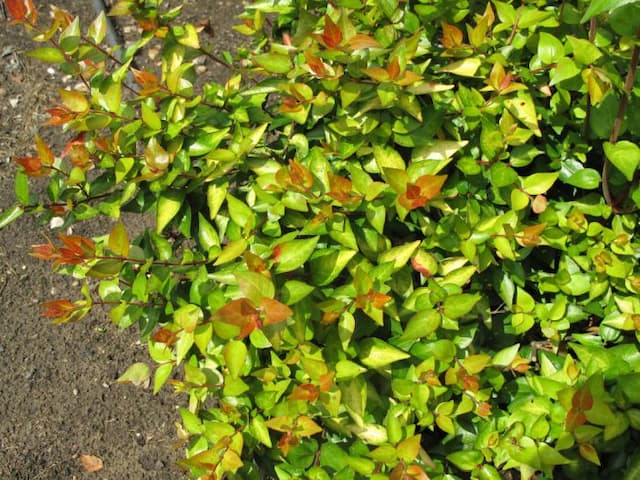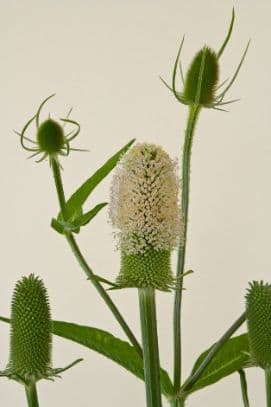Yunnan Honeysuckle Lonicera ligustrina var. yunnanensis

ABOUT
Lonicera ligustrina var. yunnanensis, commonly known as the Yunnan Honeysuckle, is a striking plant notable for its beautiful foliage and flowers. This variety of honeysuckle is characterized by its lush, green leaves that often exhibit a slight sheen, giving them a vibrant appearance. The leaves are typically oblong or oval-shaped and come to a soft point at their tips. The appeal of Yunnan Honeysuckle is greatly enhanced by its blossoms, which are commonly tubular in shape. These flowers exhibit a pale to deep yellow hue, with some variations displaying a subtle flush of pink or red. The blossoms are often borne in pairs and can themselves be quite showy. They will attract pollinators such as bees and hummingbirds, adding movement and life to the visual display of the plant. In addition to its lovely flowers, Yunnan Honeysuckle may also produce berries. The berries can range in color from red to black, contributing additional visual interest to the plant throughout its lifecycle. The overall appearance of the plant is one of lushness and vibrancy, making it a popular choice for ornamental use in gardens and landscapes where it can thrive without consideration of its dimensions.
About this plant
 Names
NamesFamily
Caprifoliaceae
Synonyms
Yunnan Honeysuckle, Yunnan Privet Honeysuckle, Yunnan Box Honeysuckle
Common names
Lonicera ligustrina var. mairei, Lonicera mairei.
 Toxicity
ToxicityTo humans
The plant commonly known as Yunnan honeysuckle (Lonicera ligustrina var. yunnanensis) can be toxic to humans if ingested. While not all parts of the honeysuckle are considered highly poisonous, some species contain saponins or glycosides that can cause discomfort and illness when consumed. Possible symptoms of honeysuckle toxicity can include abdominal pain, diarrhea, nausea, and vomiting. Eating large quantities can potentially result in more serious consequences. It’s important to seek medical attention promptly if any part of the plant has been consumed and symptoms of poisoning appear.
To pets
For pets, Yunnan honeysuckle (Lonicera ligustrina var. yunnanensis) can also be toxic. Just like in humans, ingestion of parts of the plant, which may contain saponins or glycosides, can cause a range of symptoms. These may include gastrointestinal upset, such as vomiting and diarrhea, and in severe cases, could lead to more serious issues such as lethargy or difficulty breathing. It's crucial to prevent pets from chewing on or eating any part of this plant, and to seek veterinary care immediately if you suspect your pet may have ingested some amount of Yunnan honeysuckle.
 Characteristics
CharacteristicsLife cycle
Perennials
Foliage type
Deciduous
Color of leaves
Green
Flower color
Yellow
Height
9 feet (2.74 meters)
Spread
9 feet (2.74 meters)
Plant type
Shrub
Hardiness zones
5
Native area
China
Benefits
 General Benefits
General Benefits- Attract Pollinators: Lonicera ligustrina var. yunnanensis, commonly known as Yunnan Honeysuckle, is valued for its flowers which attract bees, butterflies, and other beneficial pollinators to the garden.
- Aesthetic Appeal: With its attractive foliage and sweet-smelling flowers, Yunnan Honeysuckle adds visual interest and fragrance to landscapes and gardens.
- Habitat Provider: This plant offers shelter and nesting sites for various birds and small wildlife, contributing to local biodiversity.
- Erosion Control: The roots of Yunnan Honeysuckle can help stabilize soil and prevent erosion on slopes or banks.
- Low Maintenance: Generally hardy and easy to grow, this plant does not require significant care or resources, making it a practical addition to many gardens.
- Drought Resistance: Once established, this variety of honeysuckle can tolerate periods of drought, making it suitable for drier climates or water-conserving landscapes.
 Medical Properties
Medical Properties- Anti-inflammatory: Lonicera ligustrina var. yunnanensis is used in traditional medicine for its potential anti-inflammatory properties.
- Antioxidant: The plant may contain compounds that have antioxidant effects.
- Antibacterial: There are claims in traditional herbal medicine that suggest it has antibacterial activity.
- Antiviral: It is sometimes used in herbal mixtures with purported antiviral benefits.
- Febrifuge: The plant may be used to reduce fever, as part of traditional herbal practices.
- Treatment of upper respiratory infections: It has been used in traditional medicine to treat symptoms of upper respiratory infections.
 Air-purifying Qualities
Air-purifying QualitiesThis plant is not specifically known for air purifying qualities.
 Other Uses
Other Uses- Lonicera ligustrina var. yunnanensis, also known as Yunnan honeysuckle, can be used in landscaping as a tolerant hedge plant because of its dense foliage and fast-growing habit.
- The plant's fragrant flowers can attract pollinators like bees and butterflies, making it beneficial for maintaining healthy ecosystems and supporting biodiversity.
- Tough wood of Yunnan honeysuckle can be employed in creating small wooden tools or objects, as well as for crafting purposes due to its durability.
- Its twining vines can be woven into natural art pieces or living fences, integrating both functionality and aesthetics in garden design.
- Dried branches of the plant may serve as kindling or fire starters because they can catch fire easily when desiccated.
- Yunnan honeysuckle can be used in erosion control, owing to its vigorous root system that stabilizes the soil.
- This plant can be used as a natural dye source, with different parts of the plant potentially producing a variety of colors for textiles.
- It can serve as a companion plant in agroforestry systems, where its ability to attract beneficial insects supports the growth of food crops.
- The plant can be incorporated in noise reduction strategies in urban areas as its dense growth can help absorb sound.
- Culinary use of the edible flowers can be considered for garnishing or flavoring in certain dishes, although consumption should be done with caution and proper identification.
Interesting Facts
 Feng Shui
Feng ShuiThe Yunnan Honeysuckle is not used in Feng Shui practice.
 Zodiac Sign Compitability
Zodiac Sign CompitabilityThe Yunnan Honeysuckle is not used in astrology practice.
 Plant Symbolism
Plant Symbolism- Love and Devotion: As a member of the genus Lonicera, commonly known as honeysuckle, Lonicera ligustrina var. yunnanensis is often associated with love and devotion due to honeysuckle's enduring presence in gardens and its sweet fragrance, which is thought to attract love and good will.
- Bonding: Honeysuckle plants have a climbing nature, which can symbolize the strong bonding and connections in relationships as they cling and grow upon supports.
- Generosity: Honeysuckle is known for its generous offering of nectar, which attracts pollinators such as bees and hummingbirds, representing selflessness and the spirit of giving without expectation of return.
- Happiness: The sweet scent and bright flowers of honeysuckles are often associated with cheerfulness and the creation of positive atmospheres, making them symbolic of happiness and joy.
- Protection: In some folklore traditions, honeysuckle is believed to ward off evil and is planted near homes for protection, indicating its supportive and safeguarding nature.
 Water
WaterYunnan Honeysuckle should be watered regularly, especially during its active growth in spring and summer, to keep the soil consistently moist but not waterlogged. In general, watering once a week with about 1-2 gallons of water is a good starting point. During hot, dry periods, watering frequency may need to increase to twice a week, while in cooler, wetter months, it can be reduced. Always check the top inch of soil for dryness before watering. In winter, when the plant is dormant, reduce watering to every couple of weeks or when the soil is dry to the touch.
 Light
LightYunnan Honeysuckle thrives in full sun to partial shade, making it versatile for various garden spots. Ideally, it should receive at least 6 hours of direct sunlight daily but can handle some afternoon shade. This balance encourages healthy growth and abundant flowering. Avoid deep shade as it may result in fewer flowers and leggy growth.
 Temperature
TemperatureYunnan Honeysuckle can tolerate a range of temperatures, but it does best in conditions that mimic its native habitat. The ideal temperature range is between 60 and 80 degrees Fahrenheit. It can survive minimum temperatures down to about 10 degrees Fahrenheit, but prolonged exposure to freezing temperatures may damage the plant. Avoid placing it in areas where temperatures can exceed 90 degrees Fahrenheit for extended periods, as extreme heat can stress the plant.
 Pruning
PruningPrune Yunnan Honeysuckle in late winter or early spring before new growth begins to shape the plant and encourage vigorous growth. Regular pruning helps to maintain a healthy, bushy form and remove any dead or diseased wood. Trimming back approximately one third of the older stems each year promotes fresh growth and an abundance of blooms. The best time for heavy pruning is immediately after flowering if you need to manage size or rejuvenate an older plant.
 Cleaning
CleaningAs needed
 Soil
SoilThe Yunnan Honeysuckle prefers well-draining soil with a mixture of loam, peat, and sand to facilitate good aeration and drainage. A soil pH between 5.5 and 7.5 is best for this plant, aiming for a slightly acidic to neutral range. Adjustments can be made by incorporating organic matter or applying lime or sulfur to achieve the desired pH level.
 Repotting
RepottingThe Yunnan Honeysuckle should be repotted every 2-3 years to ensure it has enough space for root growth and access to fresh nutrients. The best time to repot is in the early spring before new growth begins, and using a pot only one size larger than the previous will prevent over-potting.
 Humidity & Misting
Humidity & MistingThe Yunnan Honeysuckle thrives at moderate humidity levels around 50-60%. While it can tolerate some variation in humidity, consistency is beneficial to maintain healthy growth without stressing the plant.
 Suitable locations
Suitable locationsIndoor
Ensure bright, indirect light, moderate humidity, and good air circulation.
Outdoor
Plant in partial shade, protect from harsh sun, and shelter from strong winds.
Hardiness zone
5-9 USDA
 Life cycle
Life cycleThe plant known as Yunnan Honeysuckle (Lonicera ligustrina var. yunnanensis) begins its life cycle with seed germination, which occurs in damp, well-drained soil in partial to full sunlight. After germination, the seedling stage is characterized by the emergence of the first leaves and a root system that starts to anchor the plant and absorb nutrients. As the Yunnan Honeysuckle enters the vegetative stage, it develops a woody stem and a more complex root structure, along with leaves that photosynthesize to fuel growth. The plant then reaches maturity and enters the reproductive stage, producing fragrant flowers that attract pollinators, resulting in pollination and fertilization. Following successful reproduction, it produces berries which contain seeds that, once dispersed, can germinate to start a new life cycle. Lastly, in the senescence stage, older plants eventually experience a decline in vigor and productivity until they die, completing their life cycle.
 Propogation
PropogationPropogation time
Spring-Early Summer
The Lonicera ligustrina var. yunnanensis, commonly known as the Yunnan Honeysuckle, can be propagated through softwood cuttings. This method is typically the most popular due to its simplicity and effectiveness. The ideal time for taking softwood cuttings is late spring to early summer, when the new growth is still flexible but not too tender. A cutting should be about 4 to 6 inches long and include at least two sets of leaves. The lower set of leaves should be removed, and the cut end may be dipped in rooting hormone to encourage root development. The prepared cutting is then placed in a well-draining potting mix, ensuring at least one set of leaves is above the soil. The pot should be kept moist but not soggy and placed in a warm spot with indirect light until roots have established, after which the plant can be transplanted to its final location.








